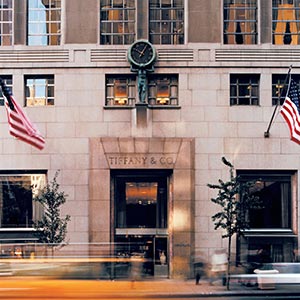
Nothing comes cheap at Tiffany & Co., as LVMH is finding out.
The luxury conglomerate has upped its offer to buy the famed retailer to almost $16 billion, or $130 a share, according to a Nov. 20 Reuters report that quoted unnamed sources.
“Tiffany plans to continue to negotiate for a better offer, and there is no certainty a deal will be reached,” the report said.
In late October, Tiffany acknowledged receiving a bid from LVMH for $120 per share, about $14.5 billion.
Reports have suggested that Tiffany’s board was seeking at least $139 a share, since its stock reached that level last year. Other reports have said that LVMH was “reluctant” to hit that benchmark.
At press time, the retailer’s stock was trading at $126 a share. Prior to news of the LVMH bid breaking, it was trading at $98.

In a Nov. 21 interview with Tiffany chief executive officer Alessandro Bogliolo at The Year Ahead: Luxury Summit, Bloomberg Television correspondent Carol Massar struggled mightily to get info on the talks, but the former Bulgari exec parried her questions by speaking in generalities, and, on occasion, making jokes.
When she asked if “other parties” are interested in buying the retailer, he replied there are “a lot of parties” at Tiffany, and when she asked if he wanted a deal, he tried to sell her a Tiffany Advent calendar.
He also declined to express a preference on whether Tiffany would be better off as part of luxury conglomerate.
“When you talk about big luxury brands…some of them are extremely successful, and are part of big groups. Consider [Louis] Vuitton, consider Cartier. But you have other brands that are super brands, super powerful, that are not part of big groups. Consider Chanel, consider Hermès. I don’t think there is a magic formula.… If there was a magic formula, then every luxury brand would follow that formula.”
His neutrality on this question represents something of a break from his predecessors, who have generally said that Tiffany should remain an independent company.
When Massar pointed to a Bloomberg opinion piece that argued that Tiffany stood to benefit from escaping the glare of the public markets, Bogliolo said that, even though his company is public, it has always tried to do “the right thing.”
“For a public company to be reporting every quarter, of course, it’s a check. As a leader of the brand with such a history, which means value, to maximize that value, me and my team have to look at the quarter, but we have to look at the next three years and the next five years.”
He noted that many Tiffany shareholders have long-term holdings in the company.
“It’s not true that a public company is only owned by speculation, index funds, or algorithms. There is a lot of that. But there are a lot of shareholders that have a very long-term approach, and they also, typically, have the biggest gain.”
He added that “customers don’t care about your shareholders. They care about your products, your brand, sustainability, the beauty of your products. This is what really makes success.”
He noted that Tiffany is now dealing with a younger generation who have a “different approach” to luxury.
“I am a baby boomer, and when I was young, [I wanted to] buy a strong brand, a famous brand, and a beautiful product, that was it. There were no more questions. Millennials have many more questions. They want to know why Tiffany is famous, what do they stand for, why should I go to them, and if the product is beautiful aesthetically, is it also beautiful inside?”
The last factor, in particular, has led Tiffany to create more of its product in-house.
“My pre-predecessor, [Michael Kowalski, was] visionary, at the end of the ’90s, to decide to vertically integrate the company upstream. We are the only global luxury jeweler to buy 80 to 90% of our solitaire diamonds, meaning 0.18 ct. and above, directly from known mines, as rough, and we internally cut and polish them.”
He said this is a double advantage for millennial consumers. “[Consumers] go to Tiffany because they have the expertise. It’s not that they buy diamonds from the wholesale market and resell it.”
But this also allowed Tiffany to announce in January that it was displaying the origin of its diamonds. This kind of transparency is now a “must” for brands, he said.
“You go to buy food. You know the fish you buy, if it comes from the Atlantic or the Pacific. [Yet] the diamond [purchased] to celebrate one of the most beautiful moments in your life, you don’t know where it comes from?… That is the obligation that Tiffany felt. And it took 20 years of investments and building skills.”
He said that Kowalski felt, “Non-conflict is not enough.… We want to make sure that the diamond that I sell you didn’t come from a country where there is infringement of human rights. I want to be sure that there is no child labor. I want to be sure that the safety in the mines is at the highest standards; we want to make sure the environment is respected.”
But it’s only recently that Tiffany decided to talk about this with consumers.
“Just five years ago we were not talking about this.… And now this has become something that is an obligation to consumers. You don’t want to have anything opaque in a diamond at Tiffany.”
(Images courtesy of Tiffany & Co.)
- Subscribe to the JCK News Daily
- Subscribe to the JCK Special Report
- Follow JCK on Instagram: @jckmagazine
- Follow JCK on X: @jckmagazine
- Follow JCK on Facebook: @jckmagazine